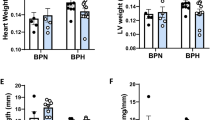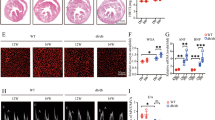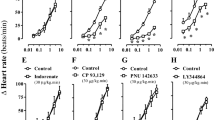Abstract
Aim:
To investigate the influence of breviscapine on high glucose-induced hypertrophy of cardiomyocytes and the relevant mechanism in vitro and in vivo.
Methods:
Cultured neonatal cardiomyocytes were divided into i) control; ii) high glucose concentrations; iii) high glucose+PKC inhibitor Ro-31-8220; iv) high glucose+breviscapine; or v) high glucose+NF-κB inhibitor BAY11–7082. Cellular contraction frequency and volumes were measured; the expression of protein kinase C (PKC), NF-κB, TNF-α, and c-fos were assessed by Western blot or reverse transcription-polymerase chain reaction (RT-PCR). Diabetic rats were induced by a single intraperitoneal injection of streptozotocin, and randomly divided into i) control rats; ii) diabetic rats; or iii) diabetic rats administered with breviscapine (10 or 25 mg·kg−1·d−1). After treatment with breviscapine for six weeks, the echocardiographic parameters were measured. All rats were then sacrificed and heart tissue was obtained for microscopy. The expression patterns of PKC, NF-κB, TNF-α, and c-fos were measured by Western blot or RT-PCR.
Results:
Cardiomyocytes cultured in a high concentration of glucose showed an increased pulsatile frequency and cellular volume, as well as a higher expression of PKC, NF-κB, TNF-α, and c-fos compared with the control group. Breviscapine could partly prevent these changes. Diabetic rats showed relative cardiac hypertrophy and a higher expression of PKC, NF-κB, TNF-α, and c-fos; treatment with breviscapine could ameliorate these changes in diabetic cardiomyopathy.
Conclusion:
Breviscapine prevented cardiac hypertrophy in diabetic rats by inhibiting the expression of PKC, which may have a protective effect in the pathogenesis of diabetic cardiomyopathy via the PKC/NF-κB/c-fos signal transduction pathway.
Similar content being viewed by others
Log in or create a free account to read this content
Gain free access to this article, as well as selected content from this journal and more on nature.com
or
References
Wild S, Roglic G, Green A, Sicree R, King H . Global prevalence of diabetes: estimates for the year 2000 and projections for 2030. Diabetes Care 2004; 27: 1047–53.
Boudina S, Abel ED . Diabetic cardiomyopathy revisited. Circulation 2007; 115: 3213–23.
Brownlee M . The pathobiology of diabetic complications: a unifying mechanism. Diabetes 2005; 54: 1615–25.
Beckman JA, Goldfine AB, Gordon MB, Garret LA, Creager MA . Inhibition of protein kinase C beta prevents impaired endothelium-dependent vasodilation caused by hyperglycaemia in humans. Circ Res 2002; 90: 107–11.
Quagliaro L, Piconi L, Assaloni R, Martinelli L, Motz E, Ceriello A . Intermittent high glucose enhances apoptosis related to oxidative stress in human umbilical vein endothelial cells: the role of protein kinase C and NAD(P)H-oxidase activation. Diabetes 2003; 52: 2795–804.
Naruse K, King GL . Protein kinase C and myocardial biology and function. Circ Res 2000; 86: 1104–6.
Idris I, Gray S, Donnelly R . Protein kinase C activation: isozyme-specific effects on metabolism and cardiovascular complications in diabetes. Diabetologia 2001; 4: 659–73.
Farese RV, Sajan MP, Standaert ML . Atypical protein kinase C in insulin action and insulin resistance. Biochem Soc Trans 2005; 33 (Pt 2): 350–3.
Das EN, King GL . The role of protein kinase C activation and the vascular complications of diabetes. Pharmacol Res 2007; 55: 498–510.
Hall G, Hasday JD, Rogers TB . Regulating the regulator: NF-kappa B signaling in heart. J Mol Cell Cardiol 2006; 41: 580–91.
Purcell NH, Tang GL, Yu CF, Mercurio F, DiDonato JA, Lin AN . Activation of NF-κB is required for hypertrophic growth of primary rat neonatal ventricular cardiomyocytes. Cell Biol 2001; 98: 6668–73.
Hemandez GS, Rojas CE . Role of the transcription factor NF-kappaB in the cardiac cell. Arch Cardiol Mex 2005; 75: 363–70.
Freund C, Schmidt-Ullirrich R, Baurand A, Dunger S, Schneider W . Requirement of nuclear factor-kappaB in angiotensin II- and isoproterenol-induced cardiac hypertrophy in vivo. Circulation 2005; 111: 2319–25.
Wang BW, Hung HF, Chang H, Kuan PL, Kou-Gi Shyu . Mechanical stretch enhances the expression of resistin gene in cultured cardiomyocytes via tumor necrosis factor-α. Am J Physiol Heart Circ Physiol 2007; 293: H2305–H2312.
Coronella-Wood J, Terrand J, Sun H, Chen QM . c-fos phosphorylation induced by H2O2 prevents proteasomal degradation of c-fos in cardiomyocytes. J Biol Chem 2004; 279: 33567–74.
Zhu XX, Niu XL, Chen DZ, Zhou XD, Pei JM, Zhu MZ, et al. Inhibitory effects of rosiglitazone against endothelin-1-induced proliferation of rat cardiac myocytes: the role of PKC-c-fos pathway. Nan Fang Yi Ke Da Xue Xue Bao 2008; 28: 1056–60. Chinese
Zhou H, Chen S, Wang L, He Q, Fan X . Regulation of the expression of pulmonary arterial collagen by protein kinase C and breviscapine in chronic hypoxic rats. Zhonghua Jie He He Hu Xi Za Zhi 2002; 25: 347–51. Chinese
Zhang SJ, Song Y, Zhai WL, Shi JH, Feng LS, Zhao YF, et al. Breviscapine alleviates hepatic injury and inhibits PKC-mRNA and its protein expression in brain-dead BA-Ma mini pigs. Hepatobiliary Pancreat Dis Int 2007; 6: 604–9.
Zhou W, Wang XL, Lamping KG, Lee HC . Inhibition of protein kinase C beta protects against diabetes induced impairment in arachidonic acid dilation of small coronary arteries. J Pharmacol Exp Ther 2006; 319: 199–207.
Clark WA, Decker ML, Behnke-Barclay M, Janes DM, Decker RS . Cell contact as an independent factor modulating cardiac myocyte hypertrophy and survival in long-term primary culture. J Mol Cell Cardiol 1998; 30: 139–55.
Yonemochi H, Yasunaga S, Teshima Y, Iwao T, Akiyoshi K, Nakagawa M, et al. Mechanism of beta-adrenergic receptor upregulation induced by ACE inhibition in cultured neonatal rat cardiac myocytes: roles of bradykinin and protein kinase C. Circulation 1998; 97: 2268–73.
Jun Ren, Dominguez LJ, Sowers JR, Davidoff AJ . Metformin but not glyburide prevents high glucose-induced abnormalities in relaxation and intracellular Ca2+ transients in adult rat ventricular myocytes. Diabetes 1999; 48: 2059–65.
Devereux RB, Roman MJ, Paranicas M, O'Grady MJ, Lee ET, Welty TK, et al. Impact of diabetes on cardiac structure and function: the strong heart study. Circulation 2000; 101: 2271–6.
Schannwell CM, Schneppenheim M, Perings S, Plehn G, Strauer BE . Left ventricular diastolic dysfunction as an early manifestation of diabetic cardiomyopathy. Cardiology 2002; 98: 33–9.
Poirier P, Bogaty P, Garneau C, Marois L, Dumesnil JG . Diastolic dysfunction in normotensive men with well-controlled type 2 diabetes: importance of maneuvers in echocardiographic screening for preclinical diabetic cardiomyopathy. Diabetes Care 2001; 24: 5–10.
Vasanji Z, Cantor EJ, Juric D, Moyen M, Netticadan T . Alterations in cardiac contractile performance and sarcoplasmic reticulum function in sucrose-fed rats is associated with insulin resistance. Am J Physiol Cell Physiol 2006; 291: C772–C780.
Zhou QF, Wang HX, Wang GJ, Yang YH . Accelerating effect of high glucose on NE-induced cardiac hypertrophy of the cultured myocardial cells. Chin Pharmacol Bull 2003; 19: l054–7.
Braz JC, Gregory K, Pathak A, Zhao W, Sahin B, Klevitsky R, et al. PKC-alpha regulate cardiac contractility and propensity toward heart failure. Nat Med 2004; 10: 248–54.
Hahn HS, Marreez Y, Odley A, Sterbling A, Yussman MG, Hilty KC, et al. Protein kinase C-α negatively regulates systolic and diastolic function in pathological hypertrophy. Circ Res 2003; 93: 1111–9.
Alter P, Rupp H, Maisch B . Activated nuclear transcription factor kappaB in patients with myocarditis and dilated cardiomyopathy-relation to inflammation and cardiac function. Biochem Biophys Res Commun 2006; 339: 180–7.
Abe J . Role of PKCs and NF-kappaB activation in myocardial inflammation: enemy or ally? J Mol Cell Cardiol 2007; 43: 404–8.
Higuchi Y, Otsu K, Nishida K, Hirotani S, Nakayama H, Yamaguchi O, et al. Involvement of reactive oxygen species-mediated NF-kappa B activation in TNF-alpha-induced cardiomyocyte hypertrophy. J Mol Cell Cardiol 2002; 34: 233–40.
Higuchi Y, Chan TO, Brown MA, Zhang J, DeGeorge BR Jr, Funakoshi H, et al. Cardioprotection afforded by NF-kappaB ablation is associated with activation of Akt in mice overexpressing TNF-alpha. Am J Physiol Heart Circ Physiol 2006; 290: H590–598.
Sármán B, Skoumal R, Leskinen H, Rysä J, Ilves M, Soini Y, et al. Nuclear factor-kappaB signaling contributes to severe, but not moderate, angiotensin II-induced left ventricular remodeling. J Hypertens 2007; 25: 1927–39.
Mathes E, O'Dea EL, Hoffmann A, Ghosh G . NF-kappaB dictates the degradation pathway of IkappaB-alpha. EMBO J 2008; 27: 1357–67.
Moss NC, Stansfield WE, Willis MS, Tang RH, Selzeman CH . IKKbeta inhibition attenuates myocardial injury and dysfunction following acute ischemia-reperfusion injury. Am J Physiol Heart Circ Physiol 2007; 293: H2248–H2253.
Kawamura N, Kubota T, Kawano S, Monden Y, Feldman AM, Tsutsui H, et al. Blockade of NF-kappaB improves cardiac function and survival without affecting inflammation in TNF-alpha-induced cardiomyopathy. Cardiovasc Res 2005; 66: 520–9.
Lin LL, Liu AJ, Liu JG, Yu XH, Qin LP, Su DF . Protective effects of scutellarin and breviscapine on brain and heart ischemia in rats. J Cardiovasc Pharmacol 2007; 50: 327–32.
Li XL, Li YQ, Yan WM, Li HY, Xu H, Zheng XX, et al. A study of the cardioprotective effect of breviscapine during hypoxia of cardiomyocytes. Planta Med 2004; 70: 1039–44.
Li FQ, Chen YZ . Effects of scutellarein on cardiomyocyte apoptosis and ventricular remodeling in spontaneously hypertensive rats. J Chongqing Med Univ 2002; 27: 400–2.
Liu XD, Chen YZ . The effects of breviscapine on cardiac myocyte apoptosis and expression of Bcl-2 during myocardial ischemia/reperfusion course in rats. J Guiyang Med Coll 2004; 29: 102–4.
Wu YG, Wu GZ, Qi XM, Lin H, Qian H, Shen JJ, et al. Protein kinase C β inhibitor LY333531 attenuates intercellular adhesion molecule-1 and monocyte chemotactic protein-1 expression in the kidney in diabetic rats. J Pharmacol Sci 2006; 101: 335–43.
Acknowledgements
We thank the Department of Cardiovascular Diseases, Sir Run Run Shaw Hospital, College of Medicine, Zhejiang University for the use of test instruments and equipment.
Author information
Authors and Affiliations
Corresponding author
Rights and permissions
About this article
Cite this article
Wang, M., Zhang, Wb., Zhu, Jh. et al. Breviscapine ameliorates hypertrophy of cardiomyocytes induced by high glucose in diabetic rats via the PKC signaling pathway. Acta Pharmacol Sin 30, 1081–1091 (2009). https://doi.org/10.1038/aps.2009.95
Received:
Accepted:
Published:
Issue date:
DOI: https://doi.org/10.1038/aps.2009.95
Keywords
This article is cited by
-
Effects of Dapagliflozin on Myocardial Gene Expression in BTBR Mice with Type 2 Diabetes
Cardiovascular Drugs and Therapy (2023)
-
Chronic activation of cardiac Atg-5 and pancreatic Atg-7 by intermittent fasting alleviates acute myocardial infarction in old rats
The Egyptian Heart Journal (2022)
-
Protective effects of scutellarin on acute alcohol gastric injury
Biologia (2022)
-
SIRT3-mediated inhibition of FOS through histone H3 deacetylation prevents cardiac fibrosis and inflammation
Signal Transduction and Targeted Therapy (2020)
-
Breviscapine inhibits high glucose-induced proliferation and migration of cultured vascular smooth muscle cells of rats via suppressing the ERK1/2 MAPK signaling pathway
Acta Pharmacologica Sinica (2012)



